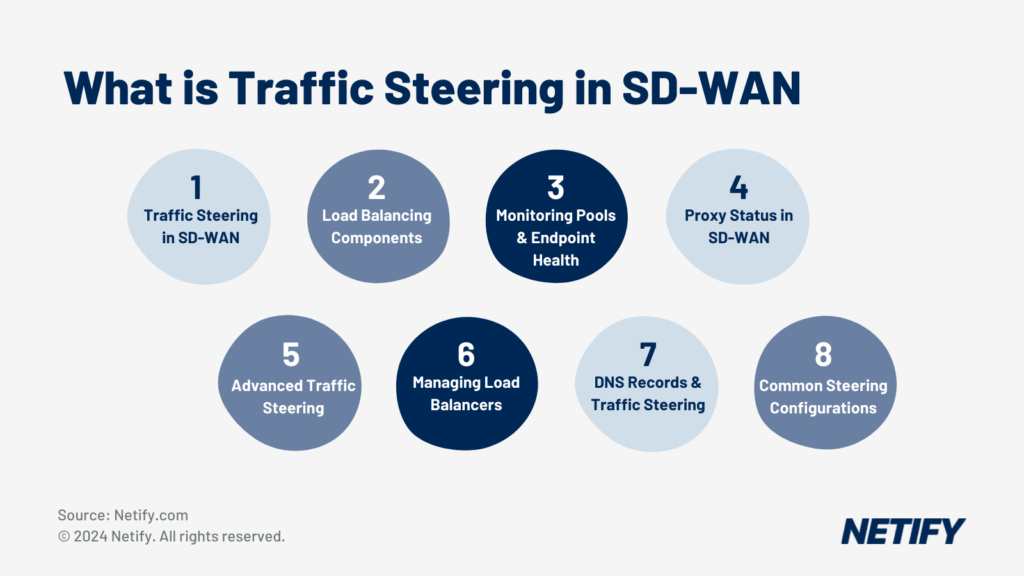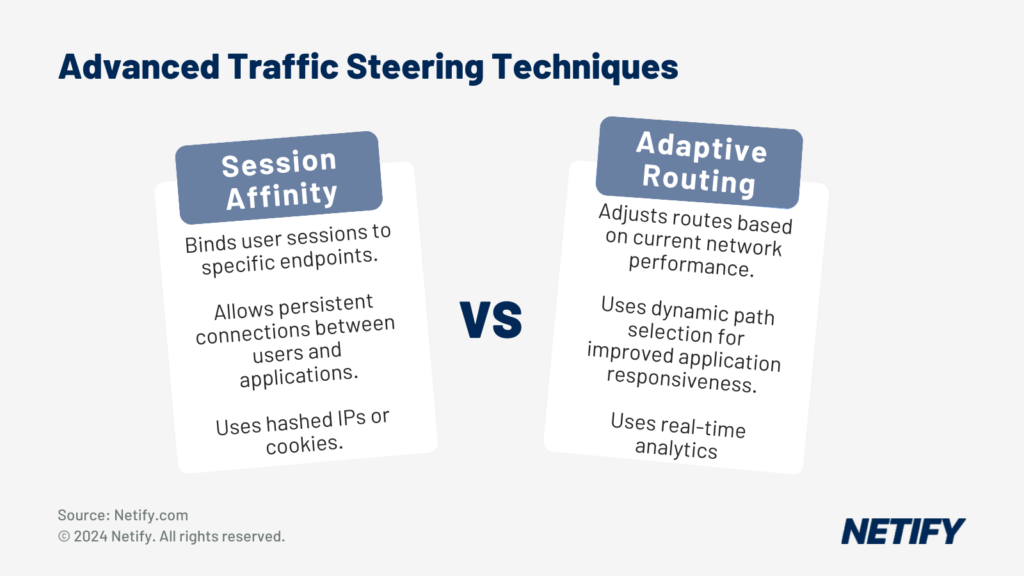What is Traffic Steering?
| Traffic Steering is used by SD-WAN to allow for routing over multiple network underlays for load balancing, prioritisation and for security regulation purposes. |
Traffic steering is an essential feature that Software-Defined Wide Area Network (SD-WAN) solutions implement to improve the performance and reliability of your business network. Traffic steering intelligently routes data across multiple paths, improving network performance, cost efficiency and agility.

In this article we’ll cover how traffic steering works, the issues it resolves and how it can benefit your business network.
Traffic Steering in SD-WAN
Traffic Steering is a technique that guides packets across various routes on your SD-WAN network in order to utilise the optimal network path for each application. The main goal of traffic steering is to balance traffic load across each different network connection, ensuring that no link becomes overwhelmed, whilst the performance of each application goes up.
By guiding data through multiple network pathways, businesses can also increase reliability and security of application traffic. Not only does this prevent link downtime (which can lead to loss of data), but it also means that sensitive traffic can be steered over specific routes in order to ensure they are better protected, such as for regulatory requirements.
Within SD-WAN traffic steering capabilities stem from features like Quality of Service (QoS) and Application-Aware Routing (AAR). Alongside QoS mechanisms, AAR can detect which applications are of higher importance to your business operations. These applications are then prioritised, allowing for critical applications to receive the bandwidth they need to perform. Traditional solutions could emulate these path selection qualities through analysis of the port being used to transmit data. This rather outdated technique was solely reliant on traffic being routed across a commonly used port for applications, therefore making this solution less appropriate for businesses with proprietary systems or applications that use non-standardised ports. AAR, however, uses Deep Packet Inspection (DPI). DPI, which examines the contents of data packets, allows AAR to identify the applications that the data is for. This method is far more flexible and efficient than port scanning, ensuring greater accuracy and connectivity of critical application traffic.
Dynamic path selection enables both human-based and SD-WAN’s automated customisation of routing rules. Dynamic path selection allows for specification of low latency and greater control over critical applications. These ensure that applications, such as VoIP calls, are affected by minimal routing issues for improved networked operations.
Load Balancing Components in SD-WAN
Beyond guiding traffic to the optimal path, traffic steering also plays a key role in balancing the load across your network. To prevent any connection from becoming overloaded with high volumes of traffic, steering can be utilised to more-evenly distribute network traffic, which is essential for preventing congestion. To implement traffic steering, businesses will either have to implement a load balancer, which can come in the form of either software or a hardware appliance, controlling the paths of networked resources.
This is especially important for larger enterprises, which can often have multiple branch offices, utilise data centres or leverage cloud services for daily operations. With these all connected via an SD-WAN solution, traffic steering can make use of pooling. Pools are groups of these endpoint locations, enabling greater load distribution and redundancy methods.
Health Monitoring of Endpoints and Pools
Whilst load balancing helps distribute traffic evenly, ensuring network stability requires continuous monitoring of endpoints and their health status. Arguably the biggest threats to businesses with networked operations are outages and downtime. These often arise from connections becoming overwhelmed, large latency spikes or hardware failures. Given their impact on day-to-day activities, protecting against these is of highest importance and one of the best ways to mitigate against these is through traffic steering. The system identifies unhealthy endpoints and redirects data to healthy ones automatically, without requiring manual intervention.
Proxy Status in SD-WAN
Proxies act as intermediary nodes within an SD-WAN solution. This means that businesses can gain secure and efficient traffic flows between these nodes. Proxies influence how data is routed and enhance performance, with monitoring detecting key metrics, such as latency, throughput and error rates.
Advanced Traffic Steering Techniques
There are two main types of advanced traffic steering techniques: Session Affinity and Adaptive Routing.
Session Affinity links user sessions to specific endpoints. This is necessary for applications that require persistent connections in order to perform. Achieving session affinity requires hashing of users’ IP or utilising cookie insertion to better keep track of sessions.
Adaptive Routing is an alternative steering technique, which adjusts routes based on current network performance. This is the typical steering technique used for dynamic path selection, which improves application responsiveness and user experience by utilising real-time analytics when making routing decisions.

Managing Load Balancers in SD-WAN
Whilst advanced steering methods optimise traffic flow, managing load balancers is equally essential for maintaining network efficiency. This is required in order to prevent network links becoming overwhelmed, these also require management. Proper management of load balancers is essential for maintaining network performance, often requiring constantly revising network configuration settings to meet the demands of ongoing traffic patterns and future business needs. Further to this, more administrative tasks like updating firmware is essential to ensure that processes do not become outdated.
DNS Records and Traffic Steering
Complementing load balancing, DNS records also play a critical role in directing traffic to the appropriate resources. DNS Records can play an important role in initial traffic direction as DNS records are used to resolve domain names into IP addresses. Managing DNS records effectively can involve regularly updating to reflect network changes, implementing low Time To Live (TTL) values for agility and utilising record types, such as A, AAAA and CNAME.
Common Traffic Steering Configurations
Application Aware Routing, within SD-WAN, offers businesses with the ability to prioritise critical applications based on real-time conditions and SLAs. AAR can evaluate telemetry from network connections using Bidirectional Forwarding Detection (BFD), allowing for the SD-WAN solution to determine the best possible route at any given time. BFD pre-empts where issues may occur within the network and will suggest an alternate route when performance begins to degrade.
Quality of Service (QoS) is a set of techniques to manage traffic across a network in order to optimise preferential performance. These optimisations vary between solutions but may prioritise specific network traffic, critical applications or services, allowing networks to increase reliability and maintain consistent performance. Techniques for QoS typically include traffic classification, queuing and scheduling in order to improve network efficiency. By increasing network efficiency, QoS reduces congestion and latency, whilst the overall user experience (UX) of the network is improved.
Conclusion
Traffic Steering is an essential feature for SD-WAN networks, providing improved performance and reliability for your business network. From switching to the fastest path, to making sure that no link becomes overwhelmed with traffic, traffic steering offers many benefits.
By aligning traffic steering configurations with your business demands, through settings for features such as QoS, AAR and dynamic path selection, critical applications can be better prioritised.